
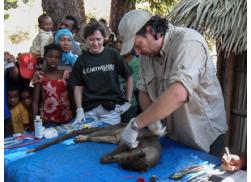
Julia Osterman: Why the fossa? Of all the animals in Madagascar, why did you choose to focus on the fossa in particular?
Dr. Luke Dollar: Madagascar is one of the world’s top biodiversity conservation hotspots. It’s got more endemic species under threat than any other place on Earth. It’s got more species found nowhere else on the planet that are facing immediate extinction than almost any other ecosystem in existence. Madagascar is a really unique place, and almost 85 percent of what you find there is found only there. That, combined with the fact that less than 10 percent of the overall original habitat remains, makes for a pretty dire conservation concern. At the top of the food chain across all of these systems is one animal – the fossa. We knew it existed 150 years ago, but we haven’t found out anything about it until the last fifteen or so years.
When I first went to Madagascar, I went for the same reason that everybody else does, which is to go study lemurs. But this lemur that I was there to study was eaten by this carnivore that nobody knew anything about – that everybody was terrified of – and that was an opportunity. And so when I went back to Madagascar two years later, in 1996, I decided I was going to study this top carnivore in the world’s top biodiversity hotspot.
Did you involve the Malagasy people in your project from the beginning, or did you include them in your efforts as the project evolved?
The first fossa I ever caught, I put a radio collar on it, and I started tracking it, and two weeks later, the signal started coming from near a river. I said, “Oh great! They’re fishing!” They wouldn’t tolerate us following and watching them; we just had to follow their signals. But after a couple of days, it wasn’t moving as much as it should have been or as it had done over the last couple of weeks, and so we went closer and started looking for the collar. When we got close, we found out the signal was coming from the middle of the river. So we drove to the river, and we got the collar, and discovered the animal hadn’t thrown the collar, hadn’t drowned. What we found was a collar that had been cut from the fossa… this fossa had walked into a local village; the local people had surrounded it and killed it, cut the collar off its corpse and thrown it in [the river]. The first study animal I ever had was killed by local people. I realized right then and there that I was going to have to involve not only these natural species but also humans in learning about what was going on. I asked the people, “Why did you do this?” And they said, “Well, we’re afraid of the fossa.”
Madagascar has only one target for all of its folklore. In North America, we have wolves and coyotes and bears and all sorts of potential, big-bad-wolf, boogeyman folklore type characters, but in Madagascar, there’s only one thing: the fossa. And so, in combination with all the folklore and the fact that people thought it was a livestock thief, it was pretty actively persecuted. People wanted to kill it. But it turns out that their biggest problems as subsistence farmers were not fossa stealing chickens; they were rats and wild pigs ruining their rice fields and harvests. Guess what eats rats and pigs in the forest? The fossa. So instead of having study animal after study animal lost to human persecution, I started a conservation education campaign to help people realize that the fossa was actually helping them.
Rice is the staple of Madagascar. The fossa was the animal that was keeping those invasive pests that were messing up rice harvests in check; the fossa is helping people by keeping those pest populations low. That was the genesis of a combination of what is now probably 40 percent science and 60 percent conservation and development work that involves local people.
How have the challenges you’ve faced in Madagascar changed over the last seventeen years?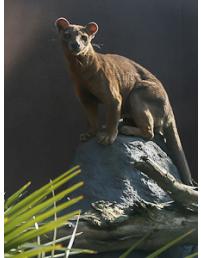
I first went in 1994. You spend that much time in a country, you get to know the people and the culture. It becomes like starting a project in your own backyard. I’ve spent more calendar time in Madagascar over the last twenty years than [in] any single place on Earth. So it really is like home, and the people that I work with are like old friends to me. I mean, how easy would it be to start doing something in your own home town?! At this point, that’s the way Madagascar feels for me, so doing things year after year, people get to know us, and they know they can trust us. They know that we will follow up on everything we discuss, and so we have this investment in each other for not only biodiversity conservation but human development and making capacity building a real option for people.
Have you seen tangible results from your efforts?
Oh, absolutely! One of the first things we did way back when we were identifying that fossa helped keep pest populations low is we made these posters that said, Arovy ny fosa, arovy ny vokotra, which in Malagasy means, “Save the fossa, save the harvest.” The sign had a little explanation of how the fossa help keep these pest populations down, and we distributed them all over the country. Years later, people would come up to me when we were redistributing new ones and say, “A fossa came into my village, but I didn’t let the people kill it because I saw that poster.” These firsthand anecdotes are very real. We have been working in one site for twelve years now, and we’ve been able to track year-to-year our trap success and identify levels of capture. The fossa population sizes in the areas where we are working have remained stable, which is really encouraging.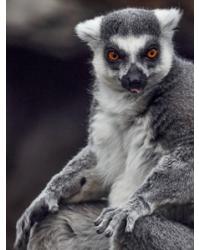
The most important ingredients to effective conservation start and finish with people. The local people that have these wonderful wildlife species in their backyards sometimes have a pre-disposition, just as we do, to take those things for granted. We’ve been working with the local people to help them realize that while they may be financially poor, the resources they take for granted are very special and make them culturally and biologically rich. People want to come and share in these experiences of essentially walking through [their] own backyard.
In doing so, the local people become engaged and very proud of the strong assets they didn’t realize they had. Not only are they proud of them for their own sake, they want to protect them because they actually mean they have opportunities for financial gain, for educational development… So we become partners, and with that sense of cooperation and camaraderie, [we] move forward for effective conservation. So it’s all about local people.
How has the political climate of Madagascar affected your project?
It’s really interesting for Madagascar right now politically because a couple of years ago there was a coup and the country was taken over by this former DJ who essentially announced himself as president and ran the old president, who was actually doing a great democratic job, out of the country. It really shook up governance in Madagascar.
Interestingly enough, because it’s such a poor and developing country, even when things were going really well with government and economic development in the urban areas, out in the rural countryside – where the biodiversity is – there wasn’t a lot of trickle down impact... The absence of a legitimate government and the lack of some of those economic booms… have had very little impact in many of the rural areas. Unfortunately, the shake up and loss of sound governance made resource exploitation and export – still considered illicit – possible because there wasn’t as much oversight and there wasn’t a fixed system of checks and balances for enforcement of those things. So in some places it has been bad, but in many of the places we work that are not near ports, it hasn’t really changed a thing.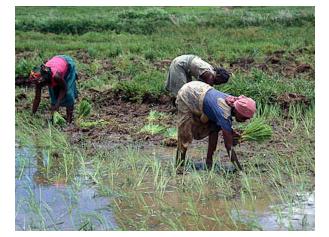
The people are living just as they lived hundreds of years ago, on a subsistence agriculture system, and are slowly finding agro-tourism benefits and other benefits preserving what little natural resources are left. They’ve been finding ways to work in the areas that have already been converted for agriculture to sustainably use them that way.
What piece of advice would you give to an aspiring conservationist?
My piece of advice for aspiring conservationists would essentially be find something you love, find something you want to protect, figure out a strategy to do it, and don’t take “no” for an answer! “No” is not a barrier; it’s just an indication that you need to ask somebody else and you need to work harder.
What do you think is the value of having people come to work hands-on on your project?
Not only are we doing lots of conservation development with local people, the trapping work for these animals is incredibly labor intensive. We have very long trap lines that people have to walk at least twice a day in order to determine whether we’ve caught an animal or not because we don’t want to leave them in the trap any longer than we have to. This requires a lot of legwork, a lot of help. It doesn’t require a whole lot of training to be able to hike these trap lines and get on a radio or a satellite phone if something’s been captured, but it’s an absolutely necessary job. One of the ways we figured out this labor conundrum was to have people from all walks of life come through the Earthwatch Institute [http://www.earthwatch.org/] and be field assistants for two weeks at a time. They can be age 15 to 75; we’ve often had that range of people. Not only are they helping directly with what’s going on at that moment in time, but they’re also having experiences and making discoveries that can shape their perspectives on the world. Particularly if they’re young and still students, [this experience] can shape the charts they make for their own future. Therefore, not only have I gotten two weeks of help out of people, but I’ve been lucky enough to help facilitate new directions for people to plan what they want to do with their rest of their lives to make the world a better place. 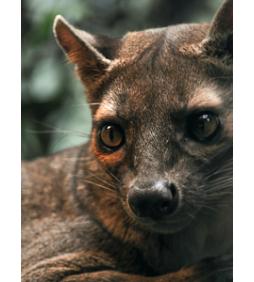
(He shows Julia his business card)
You’re the program officer? Congratulations! So what are the goals of this program and where is it heading?
All of my carnivore conservation work in Madagascar has taught me lessons about what it takes to conserve carnivores in ecosystems, to identify which ones are threatened, to realize the idiosyncrasies of place, and to grasp what the problems and solutions are in the conservation of those top predators. National Geographic asked me to help with the Big Cats Initiative. The goal of the Big Cats Initiative is carnivore conservation, just like what we’ve been doing in Madagascar with the fossa but now with big cats worldwide. We started with lions and are now working with both lions and cheetahs. We started out with a simple goal of halting the global population decline of lions by 2015. We are on a trajectory to accomplish that goal, and we’re doing it through a three-pronged approach of assessment, protection and communication.
The assessment includes a team of two dozen graduate students who are going through every available piece of historical and current information about lion and cheetah populations worldwide in order to identify historical trends, distributions, decline and current threats. With those assessments, we’re able to prioritize where we can get the biggest bang for our buck for the most effective conservation action on the grassroots level. The protection part of the initiative is facilitated through a grants program. The small grants program from the Big Cat Initiative now has funded twenty-four grants in twelve countries totaling more than $650,000. These projects are not randomly selected; they are heavily vetted, committee reviewed and approved geographically. They are population-relevant sites with effective and identified needs for conservation action to halt big cat mortality. Those two things – the assessment and the protection – feed information into the communications pillar of the initiative, bringing to bear all the leverage that all of the platforms of National Geographic can supply: digital media, magazine, television, channels and publications of all kinds. These communication ports bring awareness not only to the issues but also to the actions and successes of the initiative, which then enlists more awareness and support that feed back into this growing synergy where those three things cycle and grow in pursuit of the goal.
Images are copyright protected through Flickr Creative Commons Attribution License 2.0 Generic and may not be reproduced without permission. Copyright information for the photos are as follows: (1) Researchers, photo courtesy of Julia Osterman; (2) Fossa, photo courtesy of Keith Williams; (3) King Julian (lemur), photo courtesy of Ludovic Bertron; (4) Women in the Fields, photo courtesy of IRRI Images; (5) Fossa close-up, photo courtesy of Ludovic Bertron.